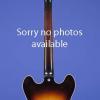One of Only Two Trini Lopez Customs Shipped in the First Year of 1964
This extremely rare Teaburst custom version (with the Barney Kessel-style body rather than the normal ES-335) weighs in at 7.20 lbs., and is one of only two Trini Lopez Customs shipped in the first year of 1964, out of a total of 302 shipped between 1964 and 1970. Laminated maple body with triple binding on top and bottom edges, two diamond-shaped sound holes with single binding, one-piece mahogany neck with a medium thickness nut width of 1 11/16 inches and a scale length of 25 1/2 inches, ebony fretboard with inlaid pearl split-diamond markers and 20 wide jumbo frets, distinctive single-side headstock. Individual Grover Roto-Matic tuners with half-moon metal buttons. Two powerful "Patent Number" humbuckers with black plastic surrounds and pickups of 7.49k and 7.12k. Four controls (two volume, two tone) plus one three-way selector switch and one stand-by switch. Tortoiseshell pickguard with single-layer cream binding, Tune-O-Matic retainer bridge with nylon saddles, trapeze tailpiece with raised diamond on cross-bar and rosewood plaque with black plastic shield, with "Trini Lopez Model" engraved in white. All hardware nickel-plated. Minimal wear on the top edge of the headstock. A wonderfully clean and totally original example in exceptionally fine condition. The sides are nicely flamed. Housed in its original Gibson black hardshell case with orange plush lining (9.00).
Trini Lopez Jr. burst onto the musical scene in 1963 thanks to his danceable rendition of "If I Had a Hammer," recorded live at Hollywood's P.J.'s club. Gibson saw the opportunity to capitalize on a new artist, thereby leaning towards a younger clientele not always familiar with the company's prestigious endorsers. Two Trini Lopez artist models were simultaneously devised in late 1964, a full-bodied Deluxe (Custom) and a thin-body Standard. The Deluxe (Custom) was essentially a variant of the regular Barney Kessel fitted with an asymmetrical Fenderish headstock, a special tortoiseshell pickguard, diamond-shaped sound holes, and a standby switch located in the upper horn. The Deluxe (Custom) was more expensive than both the Kessel Regular and the Kessel Custom, selling at $645. The spec sheets were sent to dealers in April 1965, but the two earliest samples were actually shipped at the end of 1964 (one could assume that one of these went to Trini Lopez himself -- here is the other!).
Translate:

